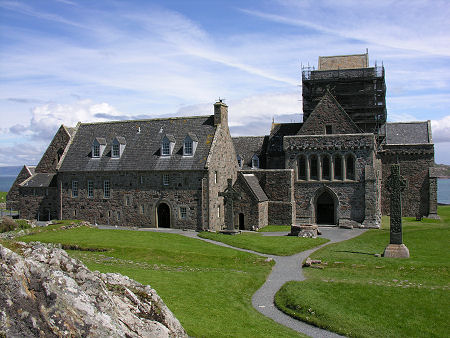 Iona Abbey |
Adomnán of Iona, also known as Saint Adomnán or Adamnan, lived from 627 or 628 to (probably) 23 September 704. He was the Abbot of Iona from 679 to 704, and is best known as the author of Life of Columba and the promoter of the hugely influential Law of Adomnán. The wider picture in Scotland at the time is set out in our Historical Timeline.
Adomnán was a descendant of a cousin of Saint Columba, Colmán mac Sétna. He is though to have been born into a noble family in what is now County Donegal in Ireland, probably as a younger son. Some historians believe he attained his obviously high level of education studying at Durrow Abbey, one of Ireland's most important early Christian monasteries. The truth is that little is known for certain: merely that he became a monk at a Columban monastery in Ireland in about 640, and then, at some later point, transferred to Iona Abbey. Opinions again differ about the date of his move to Iona, ranging from about 650, during the abbacy of Ségéne, to about 670, after the accession of Abbot Failbe.
In 679, Adomnán became the ninth Abbot of Iona Abbey. As Abbot he was extremely influential in the wider affairs of a land that was still divided between Gaels, Picts, Britons and Angles. He forged especially strong links with King Aldfrith of Northumbria. He was also influential in partially bringing the Celtic Church into line with the wider body of the Roman Church when he adopted the Roman dating of Easter. This had been agreed in 664 at the Synod of Whitby and the difference, possibly trivial to modern eyes, had led to a huge rift between the Roman and Celtic Churches.
Adomnán's most important innovation came in 697. The Synod of Birr, in Ireland, attracted a highly influential gathering of Irish, Dalriadan and Pictish nobles. Adomnán used it to gain widespread agreement to his Cáin Adomnáin or "Law of Adomnán". Also known as the "Law of Innocents", it set out to guarantee the safety and immunity of various types of non-combatant in warfare. It was a pioneering initiative in Europe and a remarkable achievement for a cleric on the Celtic fringe of the known world. Many see it as the first step in the process that has since led to the Geneva Convention and the Universal Declaration of Human Rights.
Adomnán is probably better known, however, for his Life of Columba. This was really a biography or a history of his predecessor of a century earlier as Abbot of Iona. Rather it was a "hagiography" intended to prove Columba's saintliness and extol his virtues and achievements. Despite this it is perhaps the most important surviving record from the areas which later became Scotland at this time, and generations of historians since have spent their time trying to separate out historical fact from myth and glorification. Adomnán also wrote a book about the Holy places of the Christian world based on the accounts of the Frankish Bishop Arculf, who had visited them. He also wrote a considerable amount of poetry.
Adomnán died in 704, probably on 23 September, the day now celebrated as his feast day. He was subsequently regarded as a Saint of the Celtic Church, and is often considered to have been one of the most influential participants in this early period of Irish and Scottish history.

